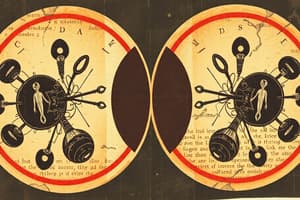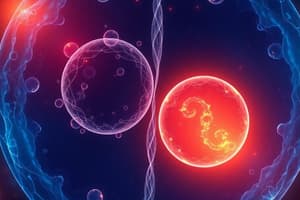Podcast
Questions and Answers
What occurs during prophase I of meiosis?
What occurs during prophase I of meiosis?
- Sister chromatids separate and move toward opposite poles.
- Homologous chromosomes pair up and crossing over may occur. (correct)
- A new nuclear membrane forms around each set of chromosomes.
- Chromosomes condense and become invisible.
In which stage of mitosis do sister chromatids separate and move towards opposite poles?
In which stage of mitosis do sister chromatids separate and move towards opposite poles?
- Metaphase
- Anaphase (correct)
- Prophase
- Telophase
What is the final outcome of meiosis II?
What is the final outcome of meiosis II?
- One diploid daughter cell.
- Two haploid daughter cells.
- Four haploid daughter cells. (correct)
- Two diploid daughter cells.
During which stage of mitosis do chromosomes align along the equator of the cell?
During which stage of mitosis do chromosomes align along the equator of the cell?
Which phase marks the transition from diploid to haploid cells in meiosis?
Which phase marks the transition from diploid to haploid cells in meiosis?
Flashcards
Mitosis
Mitosis
Cell division that produces two identical daughter cells with the same number of chromosomes as the parent cell.
Prophase
Prophase
The first stage of mitosis where chromosomes condense and become visible, the nuclear membrane disappears, and spindle fibers form.
Metaphase
Metaphase
The stage of mitosis where chromosomes line up at the center of the cell (metaphase plate).
Anaphase
Anaphase
Signup and view all the flashcards
Telophase
Telophase
Signup and view all the flashcards
Study Notes
Mitosis and Meiosis
-
Prophase (Mitosis): Chromosomes condense and become visible under a microscope. The nuclear membrane breaks down. Spindle fibers begin to form.
-
Prophase (Meiosis I): Chromosomes condense and become visible under a microscope. The nuclear envelope breaks down. Spindle fibers form. Homologous chromosomes pair up.
-
Prophase (Meiosis II): Chromosomes condense and become visible under a microscope. The spindle fibers attach to the chromosomes.
-
Metaphase (Mitosis): Chromosomes align along the metaphase plate (center of the cell).
-
Metaphase (Meiosis I): Paired homologous chromosomes align at the metaphase plate.
-
Metaphase (Meiosis II): Individual chromosomes align at the metaphase plate.
-
Anaphase (Mitosis): Sister chromatids separate and move towards opposite poles of the cell.
-
Anaphase (Meiosis I): Homologous chromosomes separate and move towards opposite poles of the cell.
-
Anaphase (Meiosis II): Sister chromatids separate and move towards opposite poles of the cell.
-
Telophase (Mitosis): Chromosomes decondense. Nuclear membranes reform. Spindle fibers break down. Cytokinesis occurs (division of the cytoplasm).
-
Telophase (Meiosis I): Chromosomes arrive at the poles. Nuclear membranes may reform. Cytokinesis may occur.
-
Telophase (Meiosis II): Chromosomes decondense. Nuclear membranes reform. Spindle fibers break down. Cytokinesis occurs.
-
Mitosis Outcome: Two identical diploid daughter cells are created.
-
Meiosis Outcome: Four haploid daughter cells are created, each with different genetic material.
Chromosome Numbers
-
Mitosis: Starts with 2n chromosomes and ends with two 2n daughter cells.
-
Meiosis I: Starts with 2n chromosomes and ends with 2n cells.
-
Meiosis II: Starts with 2n chromosomes and ends with 4 n cells.
-
2n: Diploid
-
n: Haploid
Key Differences
-
Mitosis: Used for cell growth and repair in all somatic cells and one cell division.
-
Meiosis: Used for sexual reproduction in germ cells and two cell divisions.
Studying That Suits You
Use AI to generate personalized quizzes and flashcards to suit your learning preferences.




